 This is the third part of an extended profile of Brooks Brothers, the iconic and influential American clothing company. Click here to read Part 2.
This is the third part of an extended profile of Brooks Brothers, the iconic and influential American clothing company. Click here to read Part 2.
Brooks, as it is affectionately known,created what we today view as a distinctively American sense of style – classically designed but comfortable in execution; English in heritage yet breezy and fresh in its interpretation. Brooks Brothers can also lay claim to establishing American “town” style, known also as the Wall Street look.
It’s well understood that Brooks Brothers’ impact on American style is significant and far reaching. But to pinpoint the moment in time when it literally became the arbiter of American style, we need to go back to the first half of the last century.
THE REAL GATSBY
The Roaring ‘20s ushered in a period of enormous social change and by no means was Brooks immune. The tumultuous and paradigm-shifting end of World War I released pent-up energy that led to wholesale innovations in music, culture, social morays, design and fashion. And for the first time, a distinctive American sense of style began to take shape.
Brooks Brothers took note of this cultural shift and reevaluated its own views on what men were, and wanted, to be wearing. As a result, the brand began to emerge as the standard bearer of American menswear. Shedding much of its English sartorial heritage, which up until then had been a major influence for the firm’s house style; the Brooks began to focus on the uniquely American fashion sensibilities it had helped to develop.
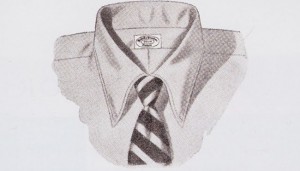 Though previously worn for sporting purposes (hard to even imagine today), the soft collared button-down shirt was resurgent in the ‘20s, now paired with more formal dress. One of the first celebrities to regularly sport this subversively stylish garment was no less than legendary Jazz Age writer F. Scott Fitzgerald.
Though previously worn for sporting purposes (hard to even imagine today), the soft collared button-down shirt was resurgent in the ‘20s, now paired with more formal dress. One of the first celebrities to regularly sport this subversively stylish garment was no less than legendary Jazz Age writer F. Scott Fitzgerald.
Already a devotee of the brand, Fitzgerald was in fact wearing his Brooks Brothers dress uniform when he met Zelda, his future wife, at a military dance. “He smelled like new goods,” she later recalled. One only needs to read the heady, detailed and lovingly crafted descriptions of the character’s wardrobes in The Great Gatsby to grasp Brook’s influence on American style and lifestyle.
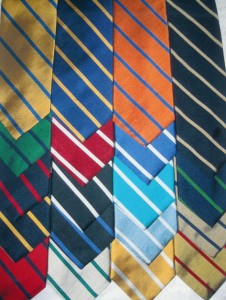 The 1920s also saw the introduction of what would become a cornerstone of the Brooks Brothers brand: the repp tie. Its distinctive striped pattern is attributed to British regimental and club ties. Brooks Americanized the repp tie by reversing the direction of the stripes. Just as stylish today as it was then, any well-dressed gent worth his salt has more than a few in his wardrobe.
The 1920s also saw the introduction of what would become a cornerstone of the Brooks Brothers brand: the repp tie. Its distinctive striped pattern is attributed to British regimental and club ties. Brooks Americanized the repp tie by reversing the direction of the stripes. Just as stylish today as it was then, any well-dressed gent worth his salt has more than a few in his wardrobe.
Though exaggerated experimentation marked the trendiest of wardrobes during this heady time, be it voluminous Oxford bags or the strangely elongated suiting silhouettes haunting jazz clubs, such as the the Zoot Suit, Brooks stood firm. While drawing on its extensive archives for inspiration and innovation, it nonetheless refused to chase the fashions of the moment.
Winthrop Brooks, president of Brooks Brothers in the 1930s and the last of the Brooks family to lead the company, famously stated, “We’re not in the fashion business. We’re in the clothing business.” This mantra has guided the company through a sea of style, social and corporate changes and, for the most part, continues to do so today. Even with today’s more polished and highly produced “heritage” themed advertising campaigns, the focus of Brooks Brothers ultimately rests on the clothes.
WELL DRESSED LUMINARIES
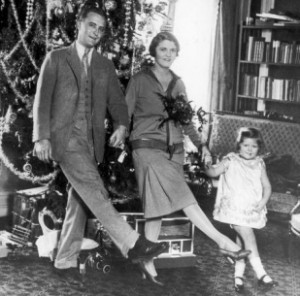 Whether residing in the fashion or clothing business, Brooks Brothers has long played a central role in American history, dressing countless political, social and cultural leaders. Its reputation as a reliable and classic American brand, always appropriate for life’s more major moments, has propelled Brooks Brothers to global status.
Whether residing in the fashion or clothing business, Brooks Brothers has long played a central role in American history, dressing countless political, social and cultural leaders. Its reputation as a reliable and classic American brand, always appropriate for life’s more major moments, has propelled Brooks Brothers to global status.
Abraham Lincoln famously wore a Brooks Brothers frock coat when he was assassinated by John Wilkes Booth. In fact, it was the same coat crafted especially for his second inauguration only five weeks previously. Hand embroidered into the coat’s lining was a design featuring an eagle, representing the United States, and the inscription, “One Country, One Destiny.”
Numerous other U.S. presidents have been loyal patrons of Brooks Brothers. Ulysses S. Grant and Teddy Roosevelt both ordered their dress military uniforms from Brooks. When he met with Winston Churchill and Joseph Stalin at Yalta, Franklin D. Roosevelt was wearing his famous Brooks Brothers great cape.
You are still able to order that same cape, now available from Brooks’ stylized Black Fleece collection. It’s expensive and highly impractical which makes is both an odd indulgence and instant conversation starter at the bar.
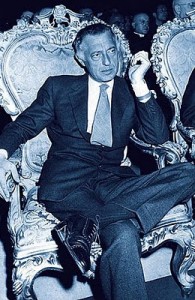 The rich, powerful and eternally stylish Gianni Agnelli famously had the habit of wearing his wristwatch over the cuff of his off-the-peg Brooks Brothers oxfords. In fact, this distinctive affection has since come the byword for those seeking to display an unstudied air of sprezzatura.
The rich, powerful and eternally stylish Gianni Agnelli famously had the habit of wearing his wristwatch over the cuff of his off-the-peg Brooks Brothers oxfords. In fact, this distinctive affection has since come the byword for those seeking to display an unstudied air of sprezzatura.
John F. Kennedy single-handedly defined his generation’s look when he wore a Brooks Brothers two-button suit at his inauguration. The slim cut and slim-lapelled two-button “Fitzgerald” suit, part of Brooks’ current lineup, pays homage to that Kennedy-era classic.
Two-button suits from Brooks, first introduced in 1961, were also favored by Gerald Ford and George H. W. Bush (that’s George senior). However, back when he was running for president in 1980, Bush was giving a speech at his alma mater, Yale University, and being heckled by some students. One yelled out that Bush was just another out of touch “Brooks Brothers Republican.” The president, apparently offended by that particular remark, promptly opened his suit coat to reveal its J. Press label (Press being a veritable Yale institution and de facto clothier to generations of Ivy Leaguers).
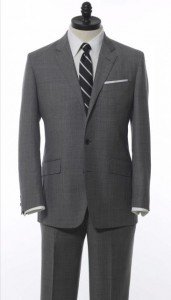 More recently, at his inauguration, President Barack Obama warded off the brutal January chill with a black cashmere topcoat and burgundy scarf from Brooks Brothers. Vice President Joe Biden is known to occasionally shut down traffic on DC’s Connecticut Avenue when he needs to swing by the store for a new tie or two.
More recently, at his inauguration, President Barack Obama warded off the brutal January chill with a black cashmere topcoat and burgundy scarf from Brooks Brothers. Vice President Joe Biden is known to occasionally shut down traffic on DC’s Connecticut Avenue when he needs to swing by the store for a new tie or two.
Of course, Brooks Brothers’ most famous former employee would be onetime tie salesman Ralph Lauren. Mr. Lauren went on to found Polo/Ralph Lauren, one of the most successful and recognized clothing brands in history.
A little known fact: Brooks Brothers actually granted Lauren the right to use the “Polo” trademark, as Brooks had retained its rights to the “original polo button-down collar” shirt. To be continued in Part 4…

Love the grey.
What you fail to mention in this corporate-sponsored hagiography is Brooks Brothers long, sad decline–from the glory of “made in our own workrooms” shirts (which may have persisted into the 1980s) to the shlock now available in outlet malls (“346” is the straight-to-outlet designator) and airports from coast to coast . . .
Rico, Please stay tuned, as I have not yet reached the point in which I discuss Brook’s current corporate structure.
That said, while I clearly understand your point of view, you are in error by suggesting that this is a Brooks Brothers’ sponsored series of posts. I have received nothing from Brooks, be it swag or even notable input. The research, writing, editing and passion are all OTC.
Of course, I am in need of a new suit or two, ahem…
I would like to applaud your use of the term “hagiography,” though. Don’t see that too often.
I’ll preface the discussion of Brooks Brother’s corporate landscape by pointing out that while for many years, particularly the late 1980s through mid-1990s, the company was indeed careening down the slope of cheapened value. However, contrary to your broadside of an incitement, the current owner has significantly improved the brand’s quality and offerings.
I don’t have the current figures on what percentage of its goods are made in the USA v. anywhere else, but to effectively compete in a global market requires a broad arsenal of strategies.
Airports? What’s the argument? Is the brand somehow cheapened or the overall quality lessened depending on the retail channel? What about buying via a website – does that alter the value or quality of the product?
As to the outlet argument, yes, the 346 brand is an outlet-specific label; just like the men’s’ “Lauren” label from PRL. Every major player has an outlet label designed to capture a particular market segment. That’s business. Personally, I can’t stand the idea of a cheapened version of a luxury brand. In this I agree with your implied message that it devalues the perception of overall quality and brand value.
But we must also remember that such a retail channel provides access to the BB brand for a customer who would otherwise not be able to afford, or choose to afford, the main line product. And a CEO who ignores that important revenue-enhancing fact should probably not be the CEO.
Thanks for your comment, I really value the input. And check back to read the next installment.
You claim that “we must also remember that such a retail channel provides access to the BB brand for a customer who would otherwise not be able to afford, or choose to afford, the main line product.” But if Brooks Brothers is such an icon, as you insist, why does it have to chase the high-volume, low-revenue market? I don’t see Apple, a true American icon, taking the low-road strategy.
More important, you claim that the “current owner has significantly improved the brand’s quality and offerings”–but compared to what and when? And what’s your evidence? T.M. Lewin and other mass-market UK merchandizers offer far more value for money.
A final point–I didn’t say that you were in the pay of Brooks Brothers. I will suggest, however, that someone who apparently fails to see the long, sad decline of the once-great Brooks Brothers is naive, undiscriminating, or on the payroll of the clothing industry? Which is it?
Rico – thank you for your follow-up comments. While I enjoy your engaging and insightful style, I find your arguments somewhat thin. It is a straw man argument to compare BB to Apple. They have completely different business models and customers. Apple seeks to maintain a brand exclusivity and mystique that negates multichannel retail. In fact, most non apple-store retail options are almost pro-forma, driving the customers to an apple store.
Apple has no desire to make available its products to a wider audience, outside of its tight channels – that would dilute the high demand its products enjoy. However, if you noticed, the new iPad 2 still has the lower quality screen of the first version (which I have and love). Why? incorporating a superior screen would increase the per-unit cost and discourage broader sales. That is, in their own way, a concession to a lower-road, volume -focused market strategy.
That said, BB makes no claim of being a Savile Row bespoke shop. It’s a company that has a very broad market and seeks to capture as much of that market as possible without eroding its brand equity. Why is that such a grievous error? How is anything that Mr. DelVecchio has done in the past 10 years conceivably worse that what Marks & Spencer inflicted on Brooks Brothers?
BB is a global business and needs to plan and act as such. While it might be nice to reflect upon a more exclusive and parochial past – with NYC, Boston and San Francisco framing out its sepia-toned world – to live solely in that past is a poor choice.
I simply disagree with you. BB is not the same company it was 10, 20, 50 or 100 years ago. Every generation has its “good old days” and so do we. Take a look at the most recent installment (Part 4) to see my thoughts on the current owner’s efforts.
Lastly, I found your parting question especially clever: am I an idiot or a shill. Sadly, I must confess to being neither. My response to the former is above, my response to the latter is this: I am in no capacity employed or reimbursed by the clothing industry in any form. Would I like to be? Most certainly.
Thanks again for the intellectual repartee.
– OTC
To your list of BB customers you may add Generals Custer and Phil Sheridan, as well as film director Raoul Walsh who’s father worked as a tailor for the company and according to Walsh, tailored some of Custer’s BB made uniforms that Custer himself had designed, and also Owen Wister author of THE VIRGINIAN. V. Carranza, president of Mexico in the revolutionary era was assassinated in a Brooks Bros suit, which for awhile, in the late 1980s, was on display in Mexico City. Sean Penn in ROLLING STONE magazine issue devoted to remembering Hunter Thompson recalls Thompson calling BB for an appointment and then going there to acquire just the right suit to attend the Academy Awards.
great reaaaaaad thank you so much =]